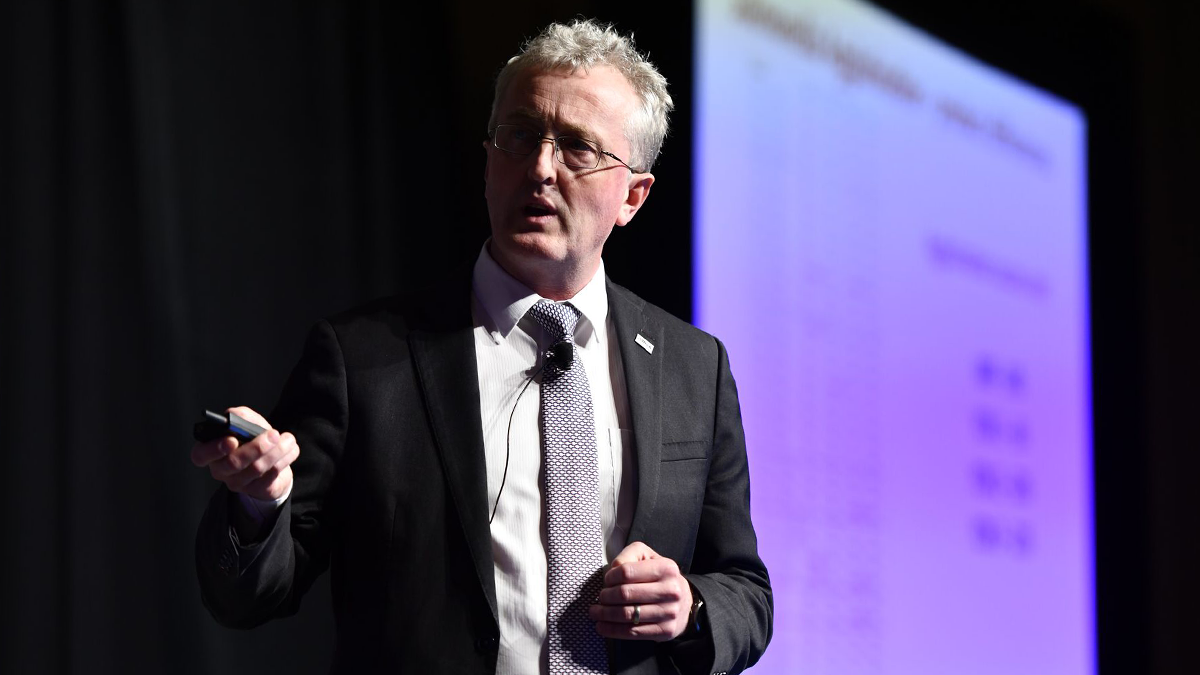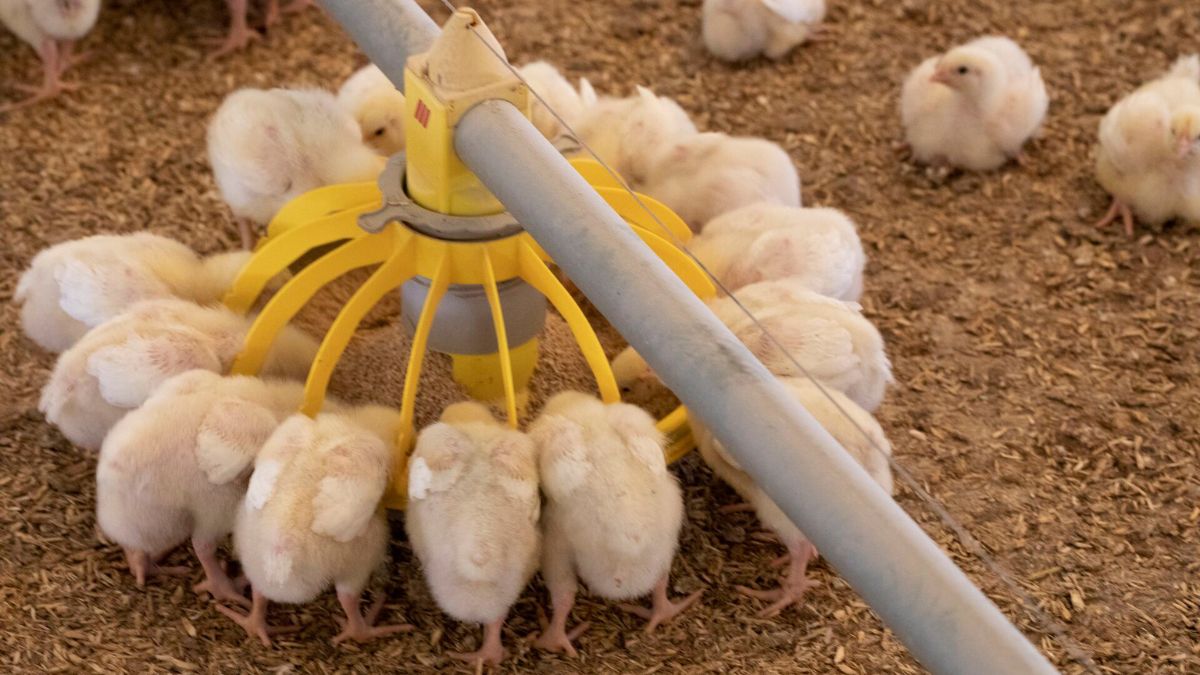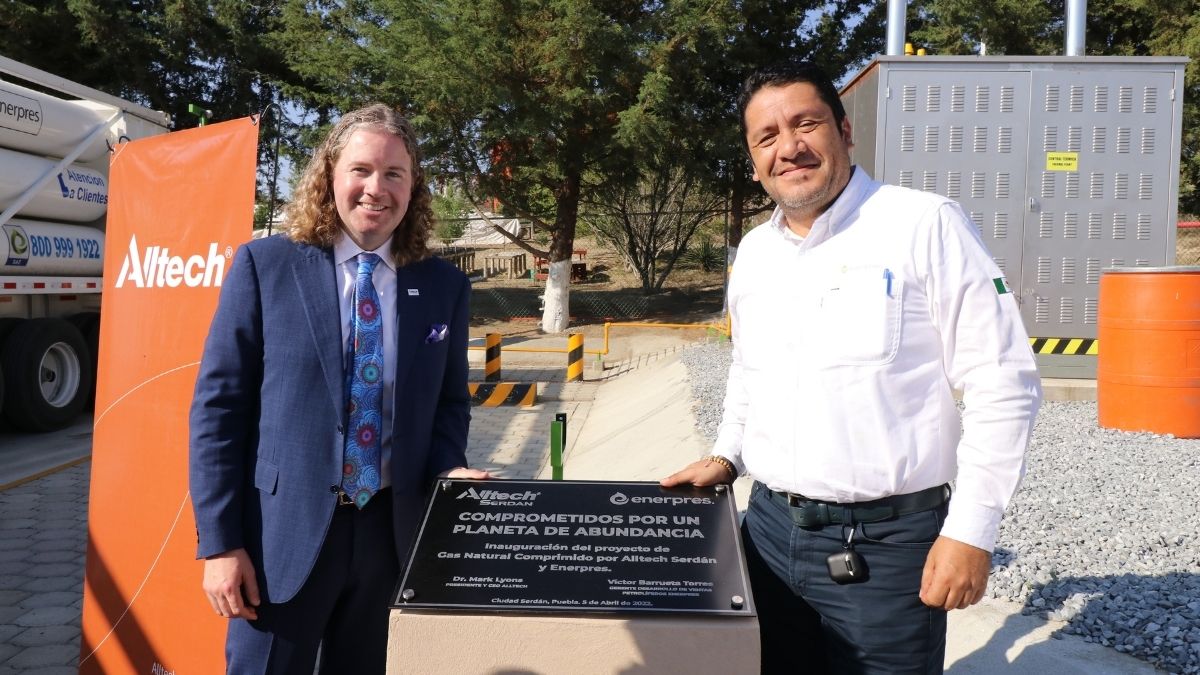The World Health Organization has identified antimicrobial resistance (AMR) as a global public health threat, but what does that mean for consumers and producers? Dr. Richard Murphy, research director of the Alltech European Bioscience Center, joins the Ag Future podcast to discuss antibiotic-free production and the link between pathogen control and control of AMR.
The following is an edited transcript of the Ag Future podcast episode with Dr. Richard Murphy hosted by Tom Martin. Click below to hear the full audio or listen to the episode on Apple Podcasts, Spotify or Google Podcasts.
Tom: Welcome to Ag Future, presented by Alltech. Join us from the 2022 Alltech ONE Conference as we explore our opportunities within agri-food, business and beyond.
Dr. Richard Murphy is the research director at Alltech's European Bioscience Centre in Dunboyne, Ireland. His research work has included the production of enzymes of industrial importance as well as the physical chemical characterization of organic trace elements and minerals, in addition to microbial fermentation technologies.
I'm Tom Martin, and Dr. Murphy joins us for an Alltech Ag Future podcast to talk about the long-term effects of antibiotic use in poultry and improving our understanding of antimicrobial resistance, or AMR. Welcome, Dr. Murphy.
Richard: Thank you very much, Tom. It's a pleasure to be with you again.
Tom: The World Health Organization has identified antimicrobial resistance as a global public health threat annually claiming at least 23,000 lives here in the U.S. alone. Where are we in our understanding of these pathogens and how to get them under control?
Richard: That's a great question to kick off, and I think it's one that we could have a very, very long discussion on. I just want to, I guess, bring it back towards the animal production side of things — poultry production, livestock production. I think what we’ve found over the last number of years, when we look at all the available data that's there, (is that) antimicrobial resistance is a persistent problem. The agriculture industry has made great strides in moving towards reductions in antibiotic usage, restricting their usage even further. But when you look at the year-on-year data, even though the usage of antimicrobials and antibiotics has decreased, we tend not to see a similar decrease in the prevalence of resistance among pathogens that would have human resonance — E. coli, Salmonella, Campylobacter.
I typically refer to resistance as being a persistent problem, and it's a challenge for the industry. As we move towards reducing our antibiotic usage or moving towards antibiotic-free or no-antibiotic-ever production systems, we still have to be mindful that there is a persistent issue and there is a persistent problem with resistance among pathogens that can cause foodborne illness. So, the challenge for producers, for poultry and livestock producers, is: How do we control pathogens and, at the same time, control antimicrobial resistance? I think that's the key, is that rather than focusing solely on antimicrobial resistance, we need to focus on the pathogens, because of the high-level prevalence of antimicrobial resistance that's present in those pathogens.
I guess the group in Dunboyne that I work with and have the pleasure of working with, we're really focused on trying to understand the link between pathogen control and control of antimicrobial resistance. That's really the key area for us at the moment, is the concept of controlling pathogens and having the added benefit of controlling antimicrobial resistance — or at least reducing the issue of antimicrobial resistance.
Tom: Okay. Before we move into pathogens, I wanted to pick up on something you said. It has to do with public perception. I wonder if public perception of this problem has caught up with the science, because it sounds to me like there have been some strides made, some improvements made.
Richard: There have been, but I don't think the general public is aware of the level and the extent of the issue. It's not just in the livestock and poultry production industries; this is across the board. You will find antimicrobial resistance in fruits, in vegetables, in soil, in water. This is a global issue, and it's not just linked to a single area like agriculture, like animal agriculture, for instance. It's everywhere. Certainly, I don't think that the public are aware of the extent of the problem, the extent of the issues. That's the key challenge, I think, is we don't want to scare the public. We certainly don't want to give them the fear that the food that they're consuming is absolutely full of antimicrobial-resistant pathogens. But at the same time, it is an issue. It is a problem that does need to be controlled.
There are many different bodies worldwide which are involved in ensuring food safety and ensuring that the food that we consume — whether it's meat, milk or eggs or even vegetable produce, for instance — ensuring that those products are safe. That's, I guess, a good message to give people, is that we know, in the industry, (that) it's a problem, but that there are great efforts made globally to control this issue and to try and understand this issue to a greater extent.
Tom: Okay. Let's talk pathogens. Which ones are showing the strongest and the highest resistance to antibiotics?
Richard: I guess, if we were to look at the big three — and we could call them the trifecta: E. coli, Salmonella and Campylobacter — they would be the biggest issues, I think, globally. There are others, like listeria, for instance. C. difficile would be an issue as well, but I think the biggest problems are among E. coli, Salmonella and Campylobacter.
Tom: In 2020, there was a paper showing the extent of AMR in the Canadian broiler industry. Can you give us some details of those findings?
Richard: Yes. This was a really nice paper, and it focused solely on the Canadian broiler industry. I think it will be remiss of me not to say now quite clearly that this isn't just a Canadian problem. This is a global problem. This just surveyed the Canadian industry.
Tom: It just happened to be Canada.
Richard: It just happened to be Canada. Among E. coli, greater than 80% of the E. coli isolates that the researchers looked at were resistant to at least one antimicrobial. Among Salmonella, it was — more than 60% were resistant to at least one antimicrobial. So, this gives you the idea or this gives you some indications of the scale of the problem. These were just looking at generic E. coli and Salmonella isolates in broiler products and broiler meat products in the Canadian industry. It's the same worldwide, unfortunately, Tom.
Tom: In fact, that research, as I understand it, did a comparison in generic E. coli isolates with those in broiler meats in Denmark, Germany, Hungary and Slovenia. Among those, Denmark had the lowest level of resistance. What is Denmark doing right?
Richard: I guess you would have to look at differences between antibiotic usage and differences between antibiotic control mechanisms that are in place in each of these jurisdictions. It may well be, as well, that there's — I guess you'd have to look at trying to compare like for like, and whether that was a fair comparison is something else to think of. But certainly, in Denmark, they have been at the forefront of trying to monitor and trying to control and reduce the usage of antimicrobials. Perhaps there are significant differences between usage patterns in Denmark and usage patterns in Canada, for instance, or in some of the other jurisdictions of the other countries.
Tom: Do high levels of antimicrobial resistance carry over from the animal to retail poultry meat?
Richard: Yes, there are studies which would show that you will have carryover of resistance from the live animals through to retail products, certainly. That's probably the most concerning area for us, is: What's the extent of carryover and what's the exposure risk, if you like, from finished products?
Tom: How is the profile of pathogens in the industry changing, and what's being done to get that under control?
Richard: Again, this is something that I've become quite interested in, Tom. You can quite easily access Food Safety and Inspection Service data from the U.S. Here, they publish quarterly figures for domestic chicken, for turkeys, for pork and for beef. You can look at the Salmonella serotypes that have been identified by the FSIS. What I've done is I've just taken a quick snapshot. From 2016 to 2021, it's actually of interest in that there are a couple of challenges, I think, for the industry, is that not only are there a wide range of serotypes; we're not just limited to one, two or three serotypes in that five- or six-year period. There were quite a number of Salmonella serotypes identified by the FSIS, some at very low levels and some at more abundant and more prevalent levels.
Among the core group, what's really of interest is that between 2016 and 2021, there has been a shift, if you like, in the serotype prevalence and serotype abundance. For instance, Salmonella enteritidis and Salmonella typhimurium have become less prevalent, whereas we see a big increase in Salmonella infantis in that five- to six-year period. For producers, that's a challenge, because you're now dealing with not only multiple serotypes, multiple serogroups of Salmonella, but you've also got temporal changes. You've also got changes in the serotype prevalence. So, whatever strategy you're using to control or restrict Salmonella prevalence and Salmonella abundance, it needs to be broad-spectrum. It needs to be able to deal with multiple serotypes and changing serotypes over time as well.
Tom: Can these resistant strains be made more sensitive to antibiotics? And even if they are, what about the public's perception and pushback against antibiotics?
Richard: Again, a great question. We've done quite a bit of work on this. I guess, if I just briefly give you an overview of what we've looked at, Tom, firstly, our main interest lies in the concept of the microbiome and how we can utilize the gut microflora as a way in which we can control pathogens in an innate fashion. If you can expand the richness and the diversity of the gut microflora, that enables the GI tract to self-police. You tend to get what's known as colonization resistance. You get greater resistance to pathogen colonization of the GI tract. We found in multiple studies across multiple species that we can affect changes. We can bring about increases in species richness (and) in gut microflora diversity with the use of mannan-based prebiotics — mannan-rich fraction, for instance.
At the same time, what we know is that when you enable an increase in diversity and when you enable colonization resistance to take place, you tend to reduce or restrict pathogen prevalence within the GI tract. So straight off, just by working at a nutritional level, you can begin to restrict the prevalence of E. coli (and) Salmonella. We found with Campylobacter, C. difficile and even Listeria that the innate properties of the gut microbiome actually means that you can begin to restrict many pathogens that have food safety implications. We've also done some additional work which looks at screening, if you like, E. coli and Salmonella isolates when we have mannan-rich fraction present in the diet and looking at the prevalence of resistance among E. coli and enterococci as well. What we have found is that when you bring about changes in the microbiome and when you bring about those population shifts that I've just mentioned, you actually restrict the extent of antimicrobial resistance, certainly amongst E. coli and certainly among enterococci. At the same time, we've focused on the prebiotic properties of mannan-rich fraction. Basically, what we're looking at here is what changes we can make in the metabolic profile or the metabolism of the bacteria, and we've used E. coli as a model organism for this.
What we found with these MRF prebiotics is that they change the metabolism behavior of the bacteria. The bacteria becomes more energized, but as it becomes more energized, it produces more toxic products. It produces more reactive oxygen species internally in the bacteria. Now, the bacteria is dealing with increased reactive oxygen species as a basic function of its own metabolic behavior. But at the same time, if you have antibiotics present, those antibiotics will also stimulate reactive oxygen species. It's a double whammy. What we've actually found, certainly, among E. coli is that in the presence of MRF-based prebiotics, metabolic function is changed, and that metabolic function actually increases the sensitivity of the bacteria to antibiotics.
Tom: This is fascinating.
Richard: I'm actually really, really passionate and really excited about this, because this is probably the first time that any group has described what you would refer to as an adjunctive impact on the antibiotic function. Now, we have a mechanism whereby antibiotics become more efficient. If you're in a situation where, for animal welfare reasons or poultry welfare reasons, you need to use antibiotics, but if you're using mannan-based prebiotics at the same time, you actually make those antibiotics more effective. That means that the likelihood, perhaps, of developing further issues with antimicrobial resistance are somewhat lessened.
That, to me, is an area that we will be doing a lot more work on, but I think that has very important implications for pathogen control in the long term. In many ways, we've got two key areas to focus on. One, we're working with the microbiome, so mannan-based prebiotics will increase the diversity of the gut microflora, and that makes the GI tract more resistant to pathogen colonization. But at the same time, we now have an inherent capability of these preparations that actually enhance the metabolism. They increase metabolic function in the pathogen, and that makes them more susceptible to antibiotics. So, it's a really, really good approach, I think, to control and restrict antimicrobial resistance.
Tom: Is MRF becoming more prevalent in animal diets?
Richard: Worldwide, we do see great usage. There are a couple of key things to think about with MRF. I would describe MRF as being like a second-generation mannan-based prebiotic. The first generation of those would have been generic, mass-type products, so these would have been rather crude, mannan-containing fractions that are isolated from the outer cell wall of Saccharomyces yeast. The groups within Alltech worked on trying to understand the more active principle or more active component from mass-based prebiotics, and that led to the development or the isolation of the second-generation mannan-rich fraction. I think what sets MRF apart from mass-based products is the relatively high proportion of certain mannan groups that are present within them — so α-(1,3) and α-(1,6) mannan-linked polysaccharides were enriched in MRF-based preparations. That's really the key to their success, Tom.
Tom: I'm listening, and I'm thinking how interesting and fun it might be to invite Dr. Murphy in my kitchen while we're preparing a meal, a poultry meal, and have you tell us what kind of precautions we need to be taking. You're observing it as a scientist who understands this. What precautions do consumers need to consider when they're preparing poultry for a meal?
Richard: (It’s) quite simple: Always cook your chicken properly. You really need to apply heat. You really need to cook it properly. That's the simple message, Tom, that consumers can take from this. If you cook your meat properly, it's perfectly safe.
Tom: This is a totally off-the-wall question, but I wonder: Does brining poultry meat have any effect on pathogens?
Richard: It will do, but it depends on the level and extent of brining that you do. You will still need to cook that brined meat properly. Brining is a popular way of controlling pathogens. Salt obviously does have an impact on pathogens, but you do need to cook that meat properly.
Tom: When you get back to work, what's on your desk? What's happening right now in this world?
Richard: We've actually got quite a number of manuscripts (and) some papers in preparation. We do have one other key strand of research in this area on the AMR site that we're planning — basically, to look at longer-term, multi-cycle studies in poultry to try and understand the benefits that we have with regard to reducing the presence and prevalence of resistant organisms in a facility with time. That, to me, is an exciting area. We've done some initial work on multi-cycle studies and shown that we have consistent impacts on not just microbiome diversity, but we also get increased microbiome uniformity.
That's an interesting area for us to explore, because if we can increase our uniformity of the gut microbiome, then that will have production benefits. Your production process, potentially, would be more standardized. That's something that we're looking at. But certainly, on the AMR side, it's trying to understand the long-term benefits in reducing the prevalence of AMR with continuous use of MRF-based prebiotics in production systems.
Tom: All right. That's Dr. Richard Murphy, research director at Alltech's European Bioscience Centre in Dunboyne, Ireland. Thank you for joining us.
Richard: Thank you very much, Tom.
Tom: For the Alltech Ag Future podcast, I'm Tom Martin. Thank you for joining us. Be sure to subscribe to Ag Future wherever you listen to podcasts.


























